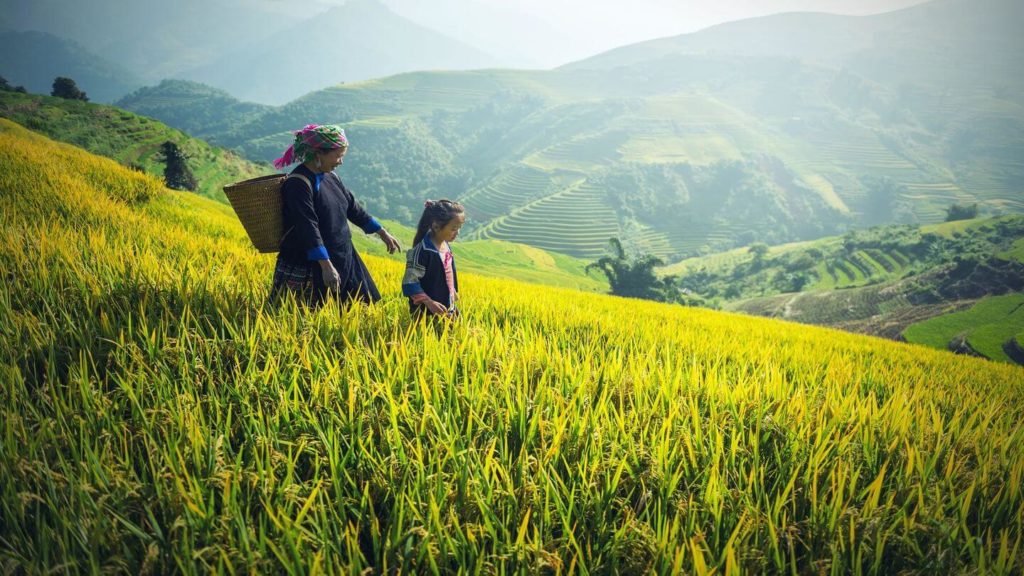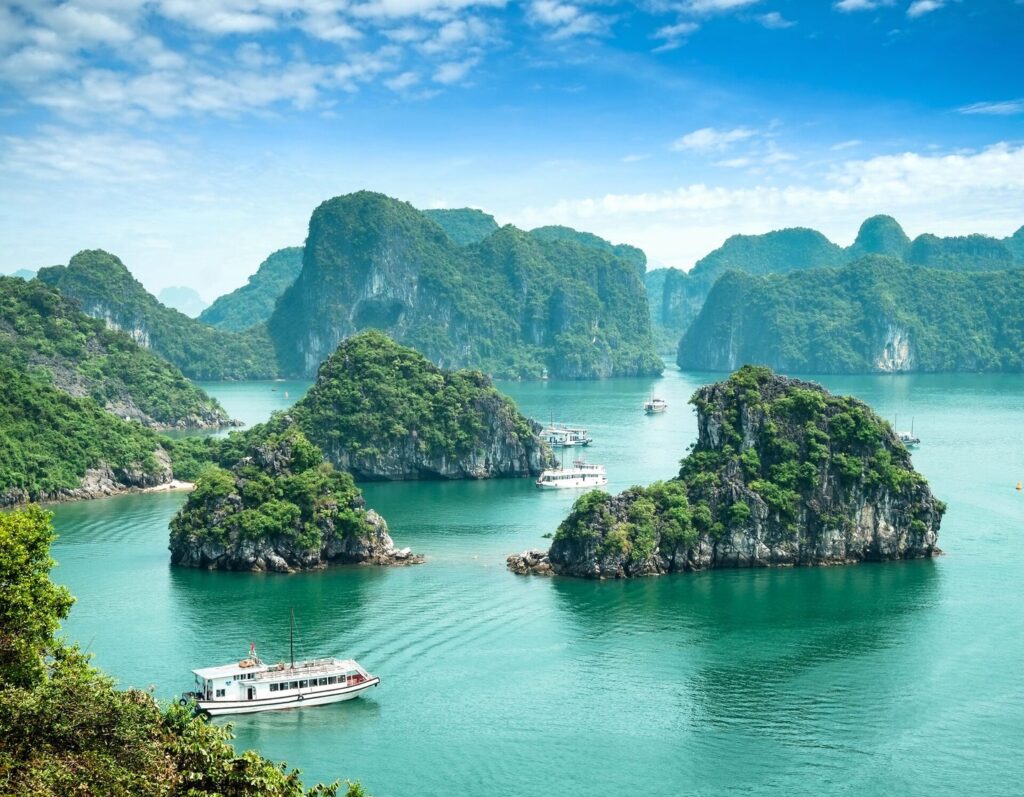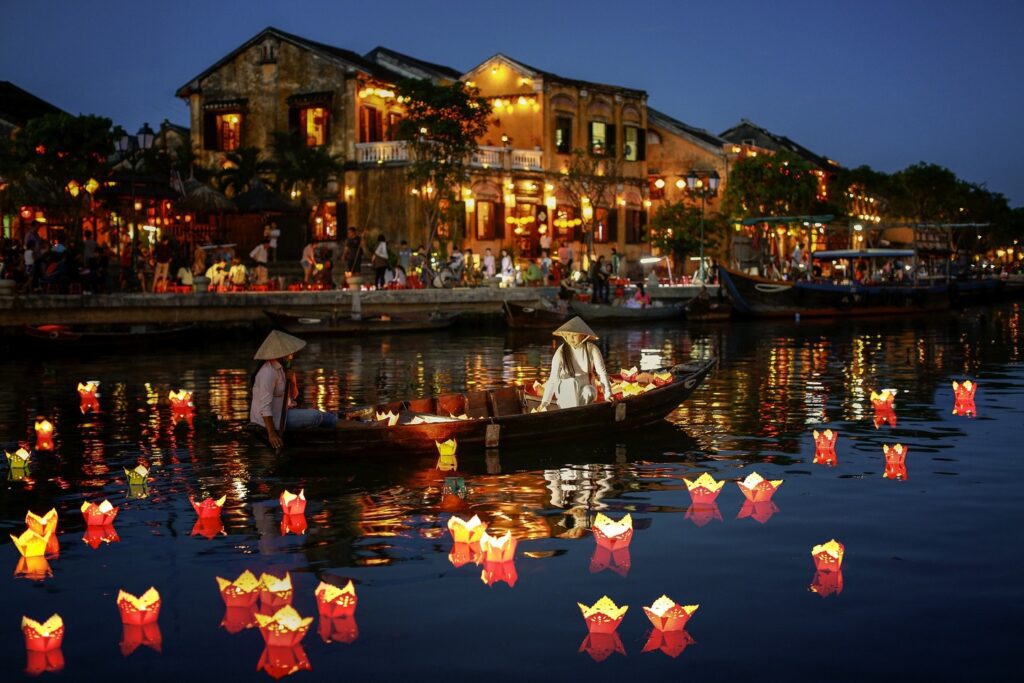Recently updated on August 7th, 2025 at 04:31 pm
A trip to Vietnam conjures up images of sailing the towering karst landscape of Ha Long Bay at sunset, or trekking through verdant rice paddies as light dances off the shimmering terraces. Vietnam is a captivating country filled with fantastically diverse landscapes, friendly locals, and fresh and vibrant cuisine. From the north to the south, this long skinny country – more than 1,000 miles long – also experiences varying weather patterns from temperate to tropical, so when is the best time to visit Vietnam?
As you’d expect, this changes from region to region, so when to visit Vietnam depends on what you’d like to see. The calendar year has times to avoid – like the Lunar New Year, and the wet season or monsoon season. Let’s dive into when is the best time to visit Vietnam, and when to avoid the Southeast Asian country.
RELATED BLOG: What to pack and how to dress in Vietnam


Best time to visit Vietnam
The best time to visit Vietnam is during the dry season, which typically runs from October to April. During these months, you can expect warm sunshine, minimal rain, and ideal conditions for exploring Vietnam’s diverse landscapes—from the limestone peaks of Halong Bay to the lantern-lit streets of Hoi An. This is the time when trekking in the northern mountains is most pleasant, the central coast enjoys bright beach weather, and southern cities like Ho Chi Minh City are at their most vibrant.
If you’re planning a cultural itinerary, this period is also packed with festivals and celebrations, including the Mid-Autumn Festival (Tet Trung Thu) in September or October, which celebrates the harvest, or the historic Huế Festival in April. Both show off come the unique culture and color of Vietnam. There is also Tết, the most important festival in Vietnam, in late January or early February, though we would actually recommend trying to avoid it.
BOOK A TRIP: Highlights of Vietnam


Worst time to visit Vietnam
Tết, or “Lunar New Year”, is the biggest celebration on the Vietnamese calendar, but similar to Thanksgiving, many Vietnamese will return to their home village to visit relatives, friends and neighbors, exchange New Year greetings, and give lucky money to children and elderly people. This means many businesses, restaurants, and tour guides may be unavailable, making it tough to enjoy as a tourist. Tết dates change each year, but fall either in January or February. Consider avoiding Tết if you’re not planning far in advance. Many services shut down, trains and hotels book out, and prices may rise. While it’s a fascinating cultural moment, it can be logistically challenging for first-time visitors.
Outside of that, many travelers try to avoid the rainy season in Vietnam, which generally falls between the typical Northern Hemisphere summer season of May and September, though the exact timing varies slightly depending on the region. This period brings high humidity, frequent downpours, and the possibility of typhoons—especially in the central and northern regions. Monsoon winds can sometimes disrupt travel plans, especially in coastal areas.
While it’s still possible to travel during the wet season, and some travelers enjoy the lush, green scenery and fewer crowds, you’ll need to pack waterproof gear, be flexible with your plans, and prepare for potential delays. If you’re hoping for sun-soaked beach days or scenic cruises, you might want to avoid this time of year.
You may also like: What to Wear in Vietnam?
Best time to Vietnam by region
Northern Vietnam (Hanoi, Sapa, Ha Long Bay)


Northern Vietnam is perhaps the country’s most dramatic region, with the misty mountains of Sapa, the awe-inspiring limestone islands of Ha Long Bay, and the buzzing capital of Hanoi. Here, the seasons feel more distinctive, and some areas like the mountainous far north actually experience four seasons rather than the typical wet/dry pattern found in the rest of the country.
During the dry weather season (November to April), temperatures in Hanoi range from 15°C to 22°C (59°F to 72°F), with Sapa seeing even cooler weather, particularly at night, where temperatures can dip to 10°C (50°F) or lower. It’s a great time to trek through the rice terraces or cruise Ha Long Bay under clear skies, though you’ll want to pack a jacket for chilly evenings in the highlands.
If you don’t mind heat and humidity, the wet season (May to October) can also be magical. Hanoi sees highs of 30°C to 35°C (86°F to 95°F) with occasional downpours. The best time to visit Sapa is in September and October, just before harvest, when the terraces glow gold and the temperatures sit around 18°C to 25°C (64°F to 77°F); warm enough to enjoy the outdoors, but cool enough for longer hikes.
VISIT VIETNAM: Vietnam and the Temples of Angkor
Central Vietnam (Hoi An, Da Nang, Nha Trang)


Beach lovers will adore the dry season (February to August) in Central Vietnam, where coastal cities and towns including Hoi An, Da Nang, and Nha Trang attract sun worshippers and fly-and-flop travelers alike. This is the hottest part of Vietnam, with average daytime temperatures between 28°C and 35°C (82°F to 95°F) and lots of sunshine. Days by the beach are blissful, but if you’re planning sightseeing, stick to February through May when the heat is more manageable.
The wet season (September to January) brings heavy rains and occasional typhoons, especially in October and November, which is often the wettest month. Temperatures cool slightly, averaging around 23°C to 27°C (73°F to 81°F), but flash floods and rough seas can impact coastal activities. As you’d expect, the crowds dwindle significantly, which could be nice in the popular ancient port town of Hoi An.
RELATED BLOG: Vietnamese street food: 11 dishes you have to try
Southern Vietnam (Ho Chi Minh City, Mekong Delta)


In Southern Vietnam, the energy of Ho Chi Minh City meets the peaceful rhythms of the Mekong Delta. The dry season (November to April) is the best time to visit this region, offering clear skies, minimal rain, and daytime temperatures ranging from 28°C to 34°C (82°F to 93°F). It’s perfect for exploring floating markets, temples, and countryside paths. You’ll also find more paradise-like destinations in South Vietnam, like the dreamy island of Phu Quoc. Just don’t forget your sunhat and water bottle.
From March to May, temperatures can soar to 40°C (104°F), particularly in the city, so plan your outings for early morning or late afternoon to avoid the peak heat.
The wet season (May to October) is marked by brief but intense afternoon showers. Temperatures stay high, around 27°C to 32°C (81°F to 90°F), and humidity can make it feel even warmer. Despite the rain, the landscape bursts into green, and the Mekong Delta becomes especially scenic with swollen rivers and rice fields in full bloom. Rain rarely lasts all day and typically won’t derail your travel plans, just bring an umbrella or poncho and embrace it.
Tour not found.What is the rainy month in Vietnam?
While Vietnam experiences a long rainy season that varies by region, October is generally considered the wettest month, especially in Central Vietnam, where typhoons and torrential rains are most common. In the south, peak rainfall typically occurs between June and September, while in northern Vietnam, July and August see the heaviest downpours. If you’re planning to travel during these months, be prepared for afternoon rain showers and check local weather forecasts regularly.
What is the cheapest time to go to Vietnam?
The cheapest time to visit Vietnam is during the low or off-season, which coincides with the rainy months from May to early October. During this period, you’ll often find discounted accommodation rates, lower flight prices, and fewer tourists. If you don’t mind the occasional rain and humidity, it’s a great way to experience Vietnam on a budget—just pack a rain jacket and be flexible with your plans.
What is the main tourist season in Vietnam?
Vietnam’s main tourist season falls during the dry months from November to April, when the weather is generally more pleasant and conducive to travel. This is especially true for northern and southern Vietnam, where mild temperatures and dry skies attract visitors from around the world. Destinations like Halong Bay, Hoi An, and Ho Chi Minh City are particularly popular during this time. Expect more crowds at major attractions and book accommodations in advance.
Best time to visit Vietnam for fewer crowds
To experience Vietnam without the crowds, plan your visit during the shoulder seasons: May to early June and late September to October. These months sit just outside the peak travel period, so you’ll enjoy a mix of milder weather, lower prices, and quieter streets. While there’s a slightly higher chance of rain, the trade-off is well worth it if you prefer a slower-paced, more local experience of this beautiful Southeast Asian country.
The best time to visit Vietnam? Possibly the shoulder seasons of April and May, or September to November when you’ll find fewer crowds, decent weather, and better prices. What do you think? Leave us a comment….